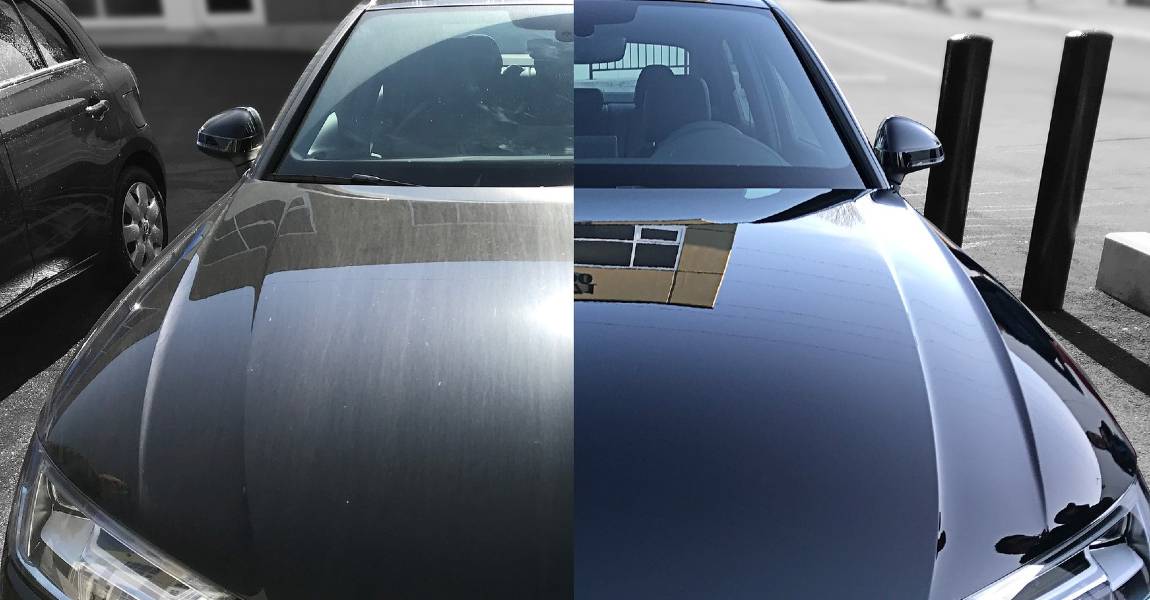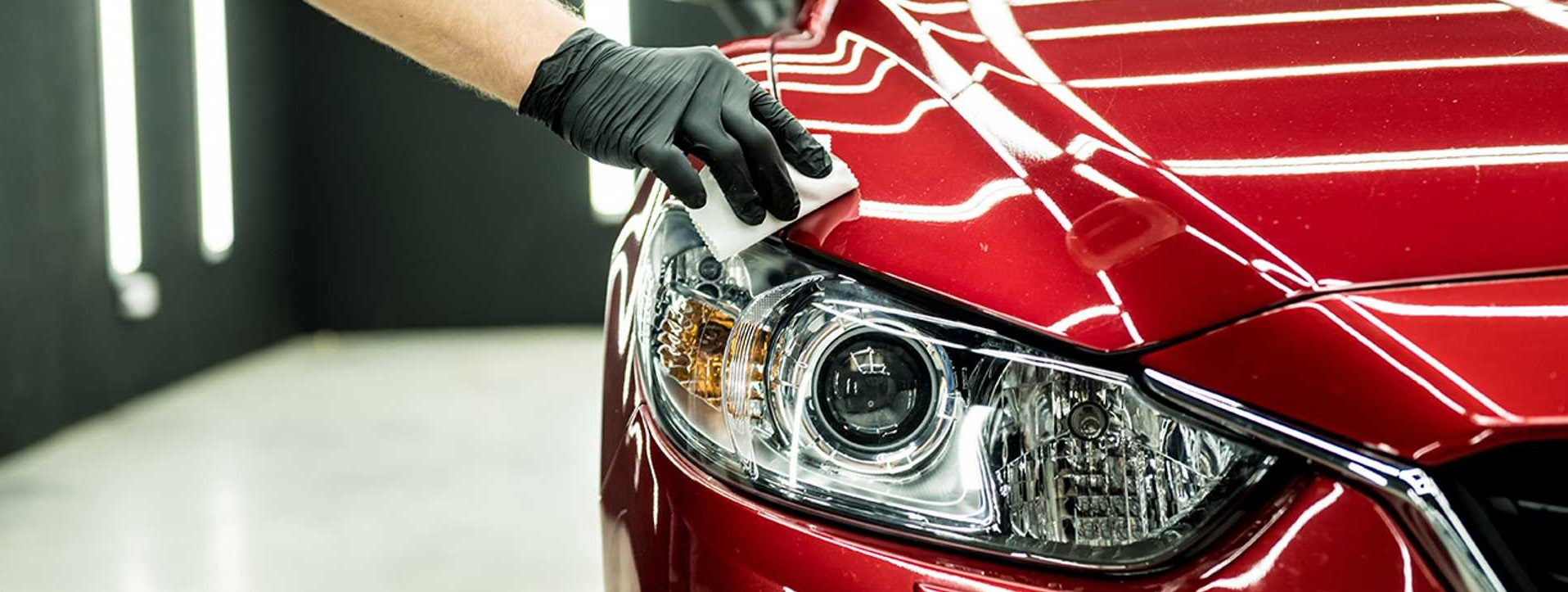How Ceramic Coating Newark can shield your vehicle from environmental wear
Wiki Article
Discovering the Scientific Research Behind Car Ceramic Coating and Its Protective Properties
The scientific research of car ceramic coating offers an interesting study in advanced auto security. Composed primarily of silicon dioxide and polymers, these layers create a robust bond with vehicle paint. This communication improves resilience versus ecological dangers while using hydrophobic benefits. However, the intricacies of just how these coatings job and their long-lasting benefits continue to be less recognized. Unboxing these details exposes why ceramic coatings are becoming a recommended option for automobile careWhat Is Ceramic Coating?
Ceramic coating is a fluid polymer that chemically bonds to the surface area of a car's paint. This innovative protective layer improves sturdiness and offers exceptional resistance to environmental elements. Unlike typical wax or sealants, which provide short-lived defense, ceramic coverings develop a resilient shield that can withstand extreme conditions such as UV rays, acidic impurities, and severe weather. When used properly, the coating forms a hydrophobic surface, causing water to bead and slide off, which assists in preserving the automobile's sanitation. Additionally, it offers improved gloss and deepness to the paint, making the automobile show up even more polished and lively. The application procedure normally involves detailed surface prep work, including cleansing and sprucing up, to ensure peak bonding. Consequently, ceramic finishings are becoming increasingly popular among car enthusiasts and those looking for to protect their financial investments, promising to keep the vehicle's visual appeal while minimizing the regularity of maintenance.The Composition of Ceramic Coatings
The elaborate formulation of ceramic coverings mainly includes silicon dioxide (SiO2), which is derived from all-natural resources like quartz and sand. This crucial element provides the structure for the coating's durability and safety top qualities. In addition to SiO2, ceramic layers frequently include different polymers and ingredients that enhance attachment, flexibility, and resistance to ecological aspects. These substances work synergistically to produce a durable obstacle versus pollutants such as dust, chemicals, and UV rays.Furthermore, some formulations incorporate titanium dioxide (TiO2) or other nanomaterials, which can boost the coating's hydrophobic properties, leading to enhanced water repellency. The exact composition can differ significantly among producers, impacting performance and longevity. Ultimately, the combination of these elements finishes in a safety layer that not only enhances the aesthetic appeal of lorries yet also serves to lengthen their life expectancy by securing the surface from possible damage.Exactly How Ceramic Coatings Work
Comprehending how ceramic finishes work entails discovering their chemical composition, which adds to their safety qualities. The application procedure is important for accomplishing perfect results, while longevity and durability factors establish the coating's efficiency with time. With each other, these elements highlight the advantages and performance of ceramic coverings for vehicle defense.Chemical Structure Explained
While numerous car proprietors look for long-lasting security for their automobiles, the chemical make-up of ceramic coverings plays a critical role in their efficiency. These layers primarily include silicon dioxide (SiO2), which is obtained from natural minerals. This compound develops a strong bond with the automobile's paint, creating a sturdy, protective layer. In addition, many ceramic layers include titanium dioxide (TiO2), boosting their hydrophobic properties and resistance to UV rays. The visibility of polysiloxanes can even more boost versatility and sturdiness. Together, these aspects contribute to the coating's ability to push back water, dirt, and impurities, while likewise offering a high-gloss coating. Understanding this chemical foundation helps car proprietors appreciate the robust protection provided by ceramic coverings.Application Process Introduction
Using ceramic coverings entails a precise process that ensures suitable bonding and security for the car's surface. Comprehensive cleaning and decontamination of the car's exterior are done to get rid of dust, crud, and previous waxes. This action verifies that the surface is totally free from pollutants that might prevent bond. Following this, the paint is typically polished to boost quality and get rid of any kind of blemishes. As soon as prepared, the ceramic coating is used in little sections making use of an applicator pad, permitting consistent protection. The coating is after that left to heal, forming a solid chemical bond with the surface area. Proper treating times and problems are crucial, as they validate the coating achieves its maximum performance and safety high qualities.Durability and Sturdiness Variables
Ceramic finishes are developed to offer resilient protection with their innovative chemical make-up, which develops a robust barrier versus environmental impurities. The sturdiness of these finishes is affected by variables such as the thickness of the application, the quality of the item, and the problems under which the vehicle is subjected. High-grade ceramic coverings can last a number of years, withstanding scratches, UV rays, and chemical spots. Proper maintenance, including routine cleaning and regular reapplication, can further enhance long life. Furthermore, environmental aspects like climate and check my blog exposure to toxins can affect the life expectancy of the coating. Overall, when used and maintained correctly, ceramic coatings supply remarkable durability, making them a prominent option for car enthusiasts looking for to maintain their vehicle's look.Hydrophobic Features and Water Repellency
Hydrophobic residential properties are a hallmark of high quality car ceramic layers, considerably boosting the vehicle's surface area performance. These coverings produce a molecular bond with the car's paint, resulting in a surface that wards off water properly. When water enters into contact with a ceramic-coated surface, it beads up and rolls off, decreasing the quantity of liquid that stays on the paint. This behavior not just contributes to a cosmetically pleasing look yet additionally decreases the buildup of pollutants such as dirt, crud, and road salts.The improved water repellency leads to less complicated cleansing and upkeep, as less initiative is needed to remove unwanted substances. On top of that, the hydrophobic nature of ceramic layers aids in stopping water areas, which can mar the surface of uncoated surfaces. In general, the unification of hydrophobic homes in ceramic finishes plays a necessary duty in keeping the automobile's excellent look while streamlining upkeep.Defense Versus Scratches and UV Damages
Car ceramic coatings offer substantial security against scrapes and UV damage. The scratch resistance system produces a sturdy layer that takes in influences, while the UV securing benefits aid keep the lorry's paint integrity over time. With each other, these have a peek at this site features contribute to a longer-lasting and aesthetically appealing surface.Scrape Resistance Device
Utilizing advanced modern technology, ceramic finishes supply a robust guard versus scrapes and UV damages, boosting the longevity and appearance of vehicle surfaces. The scratch resistance system of these layers is associated to their distinct molecular structure, which develops a resilient bond with the vehicle's paint. This bond develops a hard, protective layer that can take in influences and stand up to abrasions. Additionally, the smooth surface area of the coating reduces friction, making it difficult for contaminants to adhere and trigger scrapes. The chemical composition of ceramic layers frequently consists of nanoparticles that enhance the protective layer, further improving its strength. As a result, automobiles treated with ceramic finishings show markedly improved scratch resistance contrasted to traditional wax or sealers, making certain an excellent finish in time.UV Protecting Conveniences
The safety qualities of ceramic coverings expand beyond scrape resistance to include substantial UV sites protecting benefits. These finishes develop a durable barrier that shows damaging ultraviolet rays, safeguarding the automobile's paint and underlying products. Extended direct exposure to UV radiation can result in fading, oxidation, and damage of the paint surface. By integrating ceramic coverings, car proprietors can effectively reduce these risks, maintaining the visual appeal and honesty of their autos. Additionally, the UV obstructing properties add to enhanced long life, lowering the frequency of repainting and maintenance. Ultimately, the assimilation of ceramic finishes supplies an extensive remedy for safeguarding cars from the destructive impacts of sun exposure, making certain a continual, vivid look with time.The Durability and Maintenance of Ceramic Coatings

Regularly Asked Concerns
Can Porcelain Coating Be Applied to Any Kind of Automobile?
Ceramic coating can be put on various kinds of vehicles, including autos, vehicles, and bikes. Nevertheless, surface preparation and compatibility with specific products are important for ideal bond and performance of the coating.Just How Much Does Ceramic Coating Generally Cost?
Ceramic coating generally costs between $500 and $2,000, relying on aspects such as automobile size, coating top quality, and expert application. The investment can provide resilient protection and enhance the lorry's look over time.
Is Specialist Application Necessary for Finest Results?
The necessity of professional application commonly relies on desired outcomes. Experts typically guarantee appropriate surface area prep work and application methods, resulting in excellent bonding and durability of the coating, which might be challenging for unskilled individuals to attain.Can Ceramic Coatings Be Gotten Rid Of or Repaired?
Ceramic coverings can be gotten rid of or fixed, though the process might need details solvents or methods - Ceramic Coating Newark. Correct removal is necessary to prevent damage to the underlying surface, stressing the importance of expert assistance for excellent outcomesExactly How Does Ceramic Coating Contrast to Traditional Wax?
The contrast between ceramic coating and traditional wax exposes that ceramic coverings use exceptional resilience, improved security versus environmental pollutants, and longer-lasting luster, while wax calls for extra constant application and supplies much less total resistance to damages.Report this wiki page